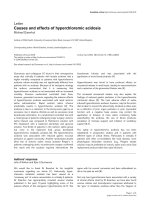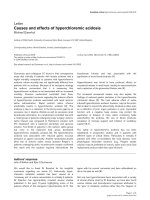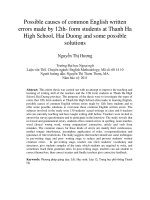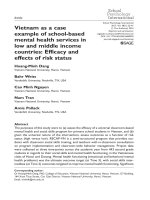School bullying causes and effects
Bạn đang xem bản rút gọn của tài liệu. Xem và tải ngay bản đầy đủ của tài liệu tại đây (43.59 KB, 3 trang )
School Bullying: Causes and Effects
Introduction
Bullying is one of the main challenges children are facing at schools. It is a global
problem that is currently affecting many youth. The rate at which bullying cases are
reported makes a lot of worries to parents. The issue is serious to the extent that
many children have learnt to live with it and some have created the notion that
bullying is part of their life in the early years of their development. Several
cases,especially in the United States and Japan, have been reported about children
humiliation, mistreatments, physical attacks, and even rape cases of young female
learners. This research paper aims at exploring the causes, effects, and the possible
solutions to bullying in schools.
Causes
According to Olweus (34), there are many reasons that lead to bullying in schools.
One of the main causes is the cultural factor. This includes race and ethnicity. A child
may be a bully or a victim if he or she comes from a majority race or the minority
race respectively. Another cause of bullying in schools is the nature of life a child is
exposed to. In many families in the developed countries, children are comfortably
allowed to watch TV even in their bedrooms. Instead of studying, such children
spend their time playing computer games. The games they play make them bullies
because they see others practice the same.
According to Tattumand Lane (27), high expectations of parents on their children
contribute to bullying. This is the case because a child will spend a lot of time
studying so as to perform well and meet the parents’ expectations. Failure to achieve
the target may develop stress in a child and they will express anger through shouting
or bullying fellow learners. Another cause of bullying in schools emanates from the
social status of the family. A child from a humble background will always have some
pressurizing needs that are not met. This child will always want to express this
frustration to the fellow learners, especially those coming from stable families by
bullying them.
Effects
The effects of bullying can be very traumatizing. Victims of bullying may opt for
dropping out of school because of the trauma they experience while at school.
Others may develop irresponsible behavior that involves missing classes on most
occasions. School irregularities among the learners result in poor performance.
Bullying leads to stress among the victims. This in turn results in poor communication
with these children. McGrath (44) argues that, in some cases, excessive bullying can
lead to victims committing suicide to escape from the painful experiences and
memories.
Some of the effects are short term, but if not well addressed, they can result into
serious complications. The victims may have bed-wetting problems, unexplained
worries, and digestive problems because of the fear that is instilled in them. Some
victims with the intention of hitting back may develop very destructive behavior.
Other victims may end up engaging in drug abuse to make them forget the painful
experiences. Bullying affects the normal development of victims and makes them
have low self-esteem.
Mitigation Measures
Mitigating bullying in schools is not a one-man battle. Since it is a global issue, it
calls for a collaborative and participatory approach in addressing the problem.
Teachers, parents and the policy makers have a big role to play in curbing this bad
behavior in schools. Teachers spend much of the time with the learners and
therefore, can easily control their behavior while in school. They should be very
tough and keen to identify the bullies and expel or suspend them from school to
avoid the spread of such behaviors among other learners. School administrators
should seriously punish the physically strong learners who take advantage of the
weak ones by mistreating them. The administration should not tolerate any sign of
bullying within the school.
Parents should also be tough with their children and avoid anything that may turn
them into bullies. Watching TV and playing computer games must be regulated at
home. If the child shows some bullying behavior while at home, he or she should be
seriously punished. The government also has a very big role to play in curbing this
vice. The policy makers must enact policies that address bullying in schools. These
policies should be implemented and strictly adhered to, and whoever violates them
should face the law irrespective of age. All the stakeholders, including the
humanitarian non-governmental organizations are to join hands to curb this vice in
the society. Through this collaborative approach, success will be achieved.
Conclusion
Bullying is a multifaceted behavior that encompasses the inflicting of physical and
emotional pain on others due to the presence of a power imbalance. Society’s
culture of failing to stop bullies who end up becoming famous for their actions
propagates the issue among other causes such as the bullies being victims of
bullying, seeking attention, and using bullying as an avenue of getting what one
wants. No individual in the world deserves to be bullied as it results in emotional
harm, poor performance in school, violence, and social problems.
Works Cited
Dupper, David. School Bullying: New Perspectives on a Growing Problem. New York:
Oxford University Press, 2013. Print.
McGrath, Mary. School Bullying: Tools for Avoiding Harm and Liability. Thousand
Oaks, Calif: Corwin Press, 2007. Print.
Olweus, Dan. Bullying at School: What We Know and What We Can Do. Oxford, UK:
Blackwell, 1993. Print.
Rigby, Ken. Bullying in Schools and What to Do About It. Melbourne, Vic: ACER,
2007. Print.
Tattum, Delwyn, and David Lane. Bullying in Schools. Stoke-on-Trent: Trentham,
1988. Print.









